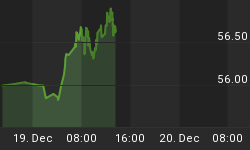I've said since the beginning of 2009 that any future "recovery" experienced by the markets and the economy would be derived through massive government spending and Federal Reserve debt monetization. Therefore, the logical conclusion must be that when or if fiscal and monetary austerity is eventually adopted, the economy and markets would crash.
More proof of that very fact was witnessed last week as the release of the January FOMC minutes showed that the governors discussed the risks of additional asset purchases, as well as the problems such additional purchases would pose for the eventual QE exit strategy.
It made little difference that no immediate action was to be taken; just the mere reminder that someday, in our yet-born grandchildren's lives, the Fed would have to stop printing money and raise interest rates. That was enough to panic investors in risk assets.
It is no coincidence that the very same day the FOMC minutes were released, commodity and equity markets plunged. This is what happens every time investors become concerned about the return of economic reality. For example, the Junior Gold Miners ETF (GDXJ) fell over 5% on Wednesday alone and the NASDAQ composite index dropped 1.5%.
This clearly illustrates what the Fed is utterly unable to see or is willing to acknowledge, namely that the economic healing process of reducing debt and inflation, which is absolutely necessary for viable economic growth, had been cut short in 2009 by Bernanke's massive monetization of government debt. Hence, our central bank and government are currently able to levitate asset prices and consumption--thus giving the temporary illusion of a recovering stock market and economy.
However, any hint of a reduction in this activity causes the eventual and necessary deleveraging process to recommence--in other words, a depression ensues in which money supply, debt levels, and asset prices are dramatically reduced. But such an economic outcome is absolutely politically untenable for D.C. and the Fed. Nevertheless, that is exactly what awaits us on the other side of government's interest rate and money supply manipulations.
Therefore, the Bernanke Fed has no real mechanism for reducing the size of its balance sheet or in its ability to raise interest rates without massive repercussions for the markets and economy. If the Fed were to pull back on its monetary stimulus now, one of the most salient outcomes would be to send the U.S. dollar soaring against our largest trading partners.
A rising Fed Funds rate and shrinking central bank balance sheet is the exact opposite direction to where the BOE, ECB and BOJ are all headed. The Keynesians that run our government fear a rapidly rising currency more than any other economic factor because they believe it would crush exports and send GDP crashing along with our markets.
In contrast, the truth is that in the long-term a rising currency is an essential ingredient for providing stable prices, low taxes, low interest rates and healthy GDP growth. However, in the short-term our government is correct in believing a soaring dollar would cause most markets to plummet; just as they did in the fall of 2008.
During the timeframe between August 2008 and March 2009, the DXY soared from 74.5 to 89, sending the S&P 500 down 50%! The same dynamics are also true at this moment in time given our continued reliance on rising asset and equity prices to keep the economy afloat.
All the hype about an imminent exit for the Fed is just noise. Not only will its policies be in place for a very long time to come, but the odds actually favor an increase to the current amount of annual debt monetization rather than a decrease.
Investors need to understand that since there is no easy escape for the Fed, they are relegated to just bluffing about an eventual exit. But bluffing alone will not be able to save the U.S. dollar or economy in the long run.















